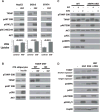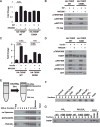Phosphorylation of TXNIP by AKT Mediates Acute Influx of Glucose in Response to Insulin
- PMID: 28591573
- PMCID: PMC5603216
- DOI: 10.1016/j.celrep.2017.05.041
Phosphorylation of TXNIP by AKT Mediates Acute Influx of Glucose in Response to Insulin
Abstract
Growth factors, such as insulin, can induce both acute and long-term glucose uptake into cells. Apart from the rapid, insulin-induced fusion of glucose transporter (GLUT)4 storage vesicles with the cell surface that occurs in muscle and adipose tissues, the mechanism behind acute induction has been unclear in other systems. Thioredoxin interacting protein (TXNIP) has been shown to be a negative regulator of cellular glucose uptake. TXNIP is transcriptionally induced by glucose and reduces glucose influx by promoting GLUT1 endocytosis. Here, we report that TXNIP is a direct substrate of protein kinase B (AKT) and is responsible for mediating AKT-dependent acute glucose influx after growth factor stimulation. Furthermore, TXNIP functions as an adaptor for the basal endocytosis of GLUT4 in vivo, its absence allows excess glucose uptake in muscle and adipose tissues, causing hypoglycemia during fasting. Altogether, TXNIP serves as a key node of signal regulation and response for modulating glucose influx through GLUT1 and GLUT4.
Keywords: AKT; GLUT4; TXNIP; glucose; insulin.
Copyright © 2017 The Author(s). Published by Elsevier Inc. All rights reserved.
Figures




References
-
- Al-Hasani H, Kunamneni RK, Dawson K, Hinck CS, Müller-Wieland D, Cushman SW. Roles of the N- and C-termini of GLUT4 in endocytosis. J Cell Sci. 2002;115:131–140. - PubMed
-
- Antonescu CN, Foti M, Sauvonnet N, Klip A. Ready, set, internalize: mechanisms and regulation of GLUT4 endocytosis. Biosci Rep. 2009;29:1–11. - PubMed
-
- Augustin R. The protein family of glucose transport facilitators: It’s not only about glucose after all. IUBMB Life. 2010;62:315–333. - PubMed
Publication types
MeSH terms
Substances
Grants and funding
LinkOut - more resources
Full Text Sources
Other Literature Sources
Medical
Molecular Biology Databases
Miscellaneous

